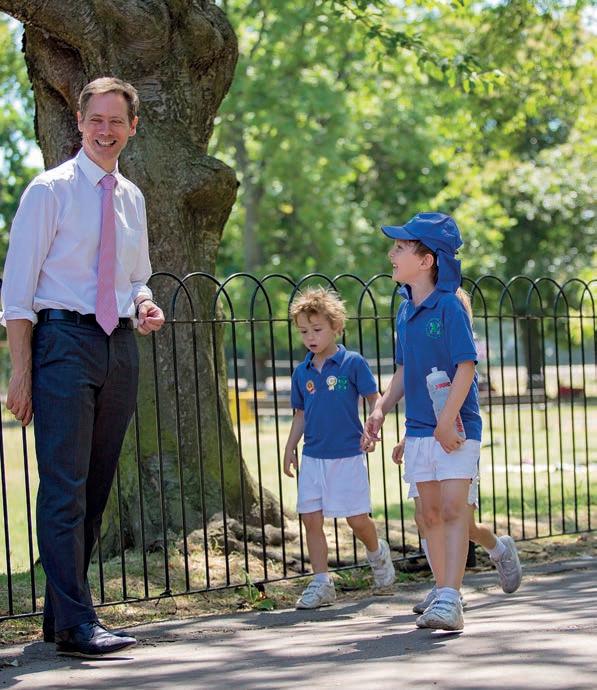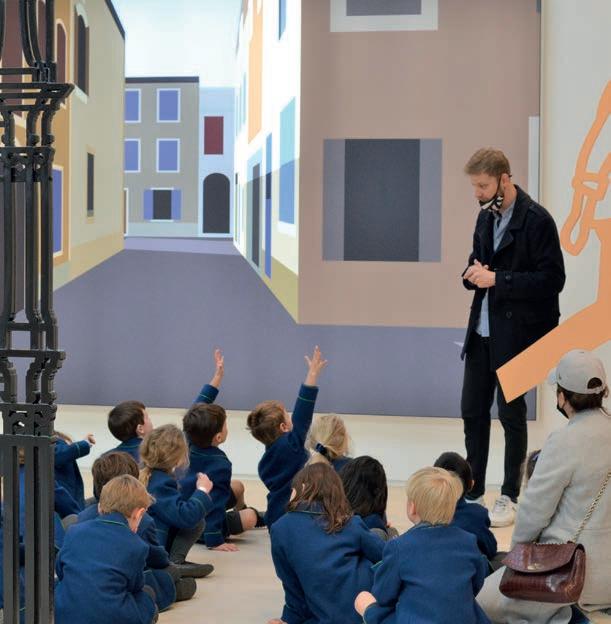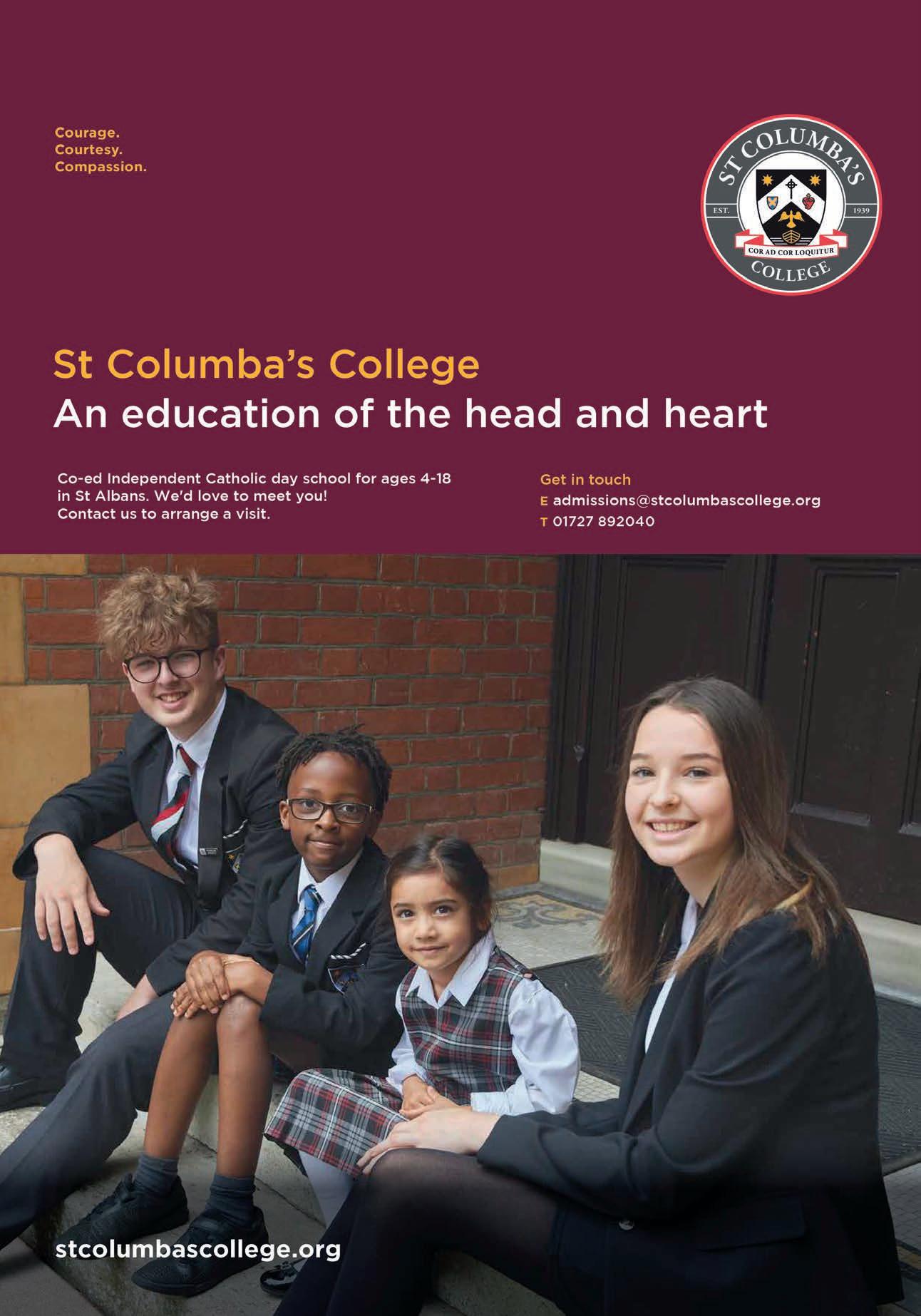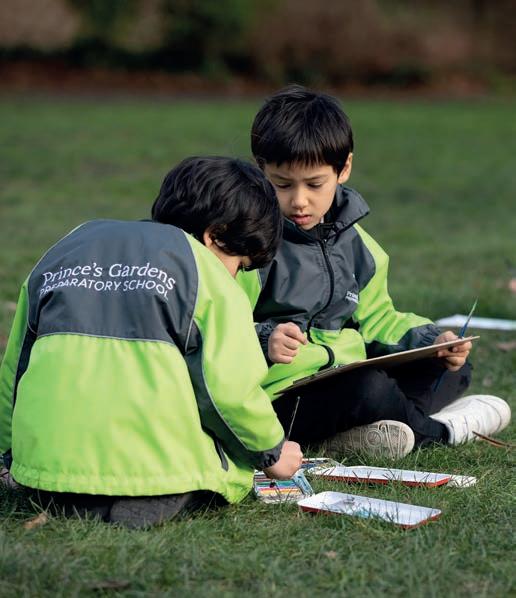
15 minute read
CAPITAL GAINS
London is a hub for culture, civic life and business, so going to school here brings added value. We explore some of the benefits of a capital education
LIBBY NORMAN
ABOVE North Bridge House pupils
Sometime around March 2020 it felt as if the world was tilting on its axis from urban to pastoral. All talk was of a move to the country, the pursuit of open spaces and a quiet life of baking sourdough. But, as life settles back onto a more familiar plane, the streets of our first city are looking busy again. London schools and their pupils carried on through the worst of pandemic times, and educators did a superb job keeping pupils feeling secure, as well as intellectually stimulated, in a city that suddenly felt unfamiliar because of the silence.
It is worth remembering that many of our top national performers – both independent and state – have long been located in the capital. These schools tap into more than the obvious resources – there are some surprising advantages when you're close to the heart of the metropolis. So, as the buzz returns to London, we gather perspectives on what a capital location brings to enrich school life and learning.
CULTURE ON TAP
When you go to school in London you're never too far away from a cultural treasure. For Prince's Gardens Preparatory School, the treasure chest is positively spilling over. Located in a quiet square in Kensington, it is only a five-minute walk (even for the smallest pupil) from the Natural History Museum, Science Museum and V&A. This means that trips to the great national museums are not an occasional expedition but a regular and immersive experience that can be fitted into an afternoon.
The team at Prince's Gardens use this ever-changing display of themes and objects to inspire all sorts of learning activities – and say it's especially useful for bringing a subject under discussion to life. It also helps to embed classroom teaching because an adventurous afternoon outing makes any topic come to life in fresh ways.
Recent examples include a visit to the V&A to support a Year 1 topic on Islam. Children looked around the Jameel Gallery and focused on masterpieces such as the Ardabil Carpet. Then they went back to class to create their own versions of this ancient masterpiece. Year 5 pupils recently headed to a lesser-known repository, the National Army Museum in Chelsea, to explore its exhibits and get deeper insights into their topic of World War II. They were able to analyse artefacts and discover what the objects were used for – all enhancing their understanding of the realities of a momentous time in global history.
For Ravenscourt Park Preparatory School (RPPS), located in west London and part of the Gardener Schools Group, WWT London Wetland Centre and the Royal Botanic Gardens at Kew are a stone’s throw away, allowing pupils to take science and nature lessons out of the laboratory and into the real world.To enrich the RE curriculum, pupils have visited the Gurdwara Sri Guru Singh Sabha Southall, the Buddhapadipa Temple in Wimbledon, and St Paul’s Church, Hammersmith.
While the school regularly makes the short journey to the major London museums, galleries and theatres, this quarter of London is its own distinct 'cultural village'. For instance, when it comes to theatre, the Lyric Theatre in Hammersmith is within walking distance and other brilliant local hubs – including the Rose Theatre in Kingston and Orange Tree Theatre in Richmond – o er a wide range of drama opportunities.
Local is also something that North Bridge House taps into. The six schools in the group, covering nursery to 18, are in north London cultural hotspots – Hampstead, Canonbury and Regent's Park. This makes them close to all the major London museums and galleries but also means stellar places on their doorstep. This is something that North Bridge House takes full advantage of. Its pupils in Hampstead can walk in the

ABOVE
Prince’s Gardens Prep pupils
BELOW
RPPS Head Carl Howes footsteps of literary and artistic giants just by taking an enrichment walk around the neighbourhood (just count the blue plaques), and with Burgh House, Keats House Museum and many other gems to tap into for study and cultural enrichment.
North Bridge House Canonbury has developed strong links with the Estorick Collection (a local gallery specialising in modern Italian art) and recently Year 12 not only went to see a new exhibition but took a special tour narrated entirely in Italian. Younger pupils also used the same exhibition to inspire their artworks. This 'insider's viewpoint' is one of the great bonuses of London school life – special relationships are formed and, be it a local or national cultural institution, these can be used to enhance students' learning experience and cultural awareness.

SPACE TO ROAM

While London is busy and built up, it's unusual for any city for its multiple parks and green spaces. And some of the best of them are on the doorstep for North Bridge House. Hampstead Heath is well-used by its Hampstead schools, which also have an exceptional sports hall on site, while Regent's Park is playtime location and sports 'home ground' for fixtures for North Bridge House Prep Regent's Park, as well as being handy for the Canonbury Senior. Pupils also make use of the other exceptional activity spaces that London o ers – for instance, Canonbury pupils go white-water rafting and mountain biking at world-class London 2012 Olympics facilities in the Lea Valley and Prep pupils play cricket at hallowed Lord's. Ravenscourt Park Prep has a generous playground and sports hall, but alongside Kew Gardens and London Wetlands Centre, it has privileged access to a plethora of exceptional west London green spaces, not least the borough flagship Ravenscourt Park right next door. This Green Flag park o ers 20 acres of space to roam in its walled gardens, wildlife and play areas and paddling pool. There's even a beach here for the summer. School sports, including tennis and basketball, can take place in the park, along with fun events such as whole-class picnics.
Prince's Gardens Prep has Hyde Park – one of London's finest green spaces – right on the doorstep, but also an amazing two-acre private walled garden that is the pride of the school. Safe and secluded, and with shade from fine old trees, it is used for forest school for the youngest pupils and play and learning throughout the year for everyone. Children keep wellies at the school so that every day can be an outdoor day. The garden is a resource for everything from Stylist Club (using natural materials to create fashion) and Gardening Club, to birdwatching, painting and science and nature lessons.

LEFT North Bridge House has central locations
RIGHT Cultural learning for Ravenscourt Park Prep

LEFT Special visitors at Ravenscourt Park Prep

RIGHT Prince’s Gardens Prep pupils get outside
REAL-WORLD IMMERSION

One huge advantage for all London schools is the free flow of ideas and access to a huge breadth of resources, thanks to privileged access to so many expert voices in civic and business life as well as a huge variety of easily accessible places to explore. This is something that touches London schoolchildren from their very earliest years – whether it's taking a school trip round the corner to buy seeds and plant pots (something North Bridge House Nursery pupils do), learning an instrument guided by a recent Royal College of Music graduate (Prince's Gardens Prep) or hearing from leading journalists and TV presenters as part of journalism week activities (Ravenscourt Park Prep).
This is where the 'buzz' of being in the capital comes into its own. Put simply, it's easier to find willing experts to enrich school learning if they happen to live and work close by. At Ravenscourt Park Prep, the team make full use of the wealth of resources close by. For example, as part of its entrepreneurial week activities, small business leaders have talked to Year 6 pupils about turning an idea into a viable business. The school finds the huge concentration of business and university expertise a real asset when it comes to developing educational themes and presenting information in engaging and salient ways.
Prince's Gardens Prep runs special career assemblies with guest speakers as part of 11+ preparation, inviting members of the parent body and experts the school has reached out to. The menu of careers discussed is diverse, just like the student and sta body, enabling a truly international perspective – and a sense of limitless possibilities – to be introduced at an important time in young people's lives and educational development.
Similarly, North Bridge House Schools’ careers forums for Prep and Senior pupils tap into the expertise of the parent body – their wide-ranging jobs and connections give students a broad vision of local, national and global opportunities. The net can be cast even wider via alumni. A famous art dealer attending a careers fair and then treating pupils to the sight of a real Picasso or Hockney as part of insights on working in the commercial art world is an unforgettable way to imagine possibilities beyond the more obvious career paths.
With all London schools, the exposure to so many influences builds awareness. North Bridge House Schools believes that this also helps to open young people's eyes to interests they can take further and sustain for life, not just careers. Litter picking in nearby parks may seem a small act in support of the local community, but also inspires children to think further about topics such as resources and environmentalism – even develop their own advocacy skills. Prep School pupils also have a collaboration with ZSL London Zoo, enabling them to go behind the scenes, talk to experts in zoology and consider what more we can all do to conserve wildlife and preserve our environment.
Then there's resilience – something that is front of mind for all parents and educators since the pandemic. It's a hard one to quantify, and there's no doubt that London students' immersion in a fast-paced environment exposes them to more ‘noise’, but it also gives them added awareness of others, perhaps more independence and certainly a sense of the big wide world beyond the school gates. This, in turn, can help to build something every child needs: a growth mindset. "In order to believe that all pathways are open to them, a child needs to see that ‘people like me can do that’. This means that schools need to ensure that the topics that they teach, the books in their library, the displays in the corridors and the speakers that they invite into school, all reflect a fully diverse society," says Carl Howes, Headmaster of Ravenscourt Park Prep. "The beauty of being in London is that it makes it possible to do this really well, thanks to the richness and diversity that the city o ers.”
ABOVE The switch to o ering outdoor classes was inspired by students

Great outdoors
Sutton High Prep School is taking class outside, with a new purpose-built space inspired by its pupils’ desire to connect with nature
Come rain or shine, Sutton High Prep School, Surrey will teach all pupils outside in a purpose-built outdoor classroom at least once a week. This change was inspired by its children, who said that walks they took during lockdown had made them calmer, happier and more able to concentrate. They also said that they wanted lessons that connected more with the environment and nature.
Sutton High Prep has begun the multimillion-pound extension to its buildings informed by these design ideas from its 4 to 11 year olds. “Just prior to the pandemic, we initiated a teaching programme called
Brains Matter, in which every morning children were asked to chart their emotional barometers and understand how and when their moods change and why. We also had weekly assemblies about how the brain works,” says Headteacher Anne Musgrove.
“This stood the girls in great stead when the pandemic hit because throughout lockdown, they were able to notice when they felt better and why – and it was invariably when they were outside, immersed in the environment.”
This knowledge translated into action when physical school returned. “When pupils returned to school and we were at the beginning of our planning stages for the extension, it became clear that they were now unhappy with being stuck inside all week. Combined with the obvious mitigations to the spread of Covid that being outside presents, along with the benefits of increased exposure to natural sunlight and vitamin D, it seemed like the obvious thing to pivot more towards outdoor learning,” adds Anne Musgrove.
The plan is that at first children will all have at least one lesson a week outdoors. These will happen in all weathers so small adjustments – wellies have now become part of the school uniform – accommodate the switch. While they are there, they will also be able to learn plant and wildlife names, conservation skills and meteorology. “As teachers research how they can use the environment to enrich more formal teaching, from maths and biology to history to art, they will use it more frequently.”
Sutton High Prep believe this extension is a golden opportunity to positively contribute towards children’s health and wellbeing. With some sobering statistics being delivered in the aftermath of the pandemic, this makes sense. Other factors contribute to good health too – being in the great outdoors is an antidote to children’s sedentary lives.
The Look Out, as it will be known, will be an outdoor terrace that accommodates up to 24 children. The floor will have a graphic paving system for outdoor maths, while planters will feature fruit and vegetables grown by the children and a compost making facility will be close by. The building project, to be completed in September, will also include more indoor classrooms, but only natural materials will be used to replicate a feeling of being in nature as much as possible. As part of that, the school is moving away from bright colours and increasing focus on more calming decor that includes plants and greenery.Indoor classrooms will open directly onto a newly planted woodland area, with free flow between the areas.
“As 20th century educationalist Margaret McMillan, who was light years ahead of her time, once said: ‘The best kept classroom and the richest cupboard are roofed only by the sky’. I think it took the pandemic to make us think more about these words,” says Anne Musgrove. “The result is an education that incorporates and works within nature because that’s what makes pupils happy.”


ABOVE Teachers are exploring how outdoor elements can be used to enrich the core curriculum

ART SPARK
Hollie Slaughter of Lyndhurst House Prep discusses art's value in developing not only practical skills but also understanding of our own emotions
The arts are a part of our daily lives at Lyndhurst House. Whether it is admiring the displays around the school, appreciating, and talking about art in assemblies, making art during art lessons and club activities or dropping into Creative Space during morning break, here everyone is involved.
Art is an important part of the curriculum at our school, and we also believe it makes life more manageable, tolerable and enjoyable. It o ers us a chance to make sense of the everchanging world around us, giving us freedom to express ourselves and develop a deeper understanding of our emotions – whether we are five or 55 years old.
There is no ‘one size fits all’ approach to our break times here at Lyndhurst House. A creative act such as crafting or drawing can help focus the mind. While many of the boys cannot wait for their chance to kick a football with their peers, others feel much more refreshed by the calming e ects of painting or other creative arts, and we value that. Creative Space runs every morning break, allowing our boys an opportunity to come in and draw, paint, sculpt or get crafty.
We have had a blast learning how to use sponges, sticks, bubble wrap, bottle

ABOVE Art at Lyndhurst House Prep
tops and pretty much anything to create abstract expressionist work. We have learnt what colours complement each other and which ones muddy our work. We have also learnt how to make incredible pour paintings with the most beautiful and intense patterned and textured outcomes – we even got into the swing of things and splatter painting using a pendulum hung from the studio ceiling. Our Painting Club is rooted in art history. For instance, the boys learn about the original abstract expressionist Jackson Pollock, as well as the lesser-known wild and wacky ways of modern-day painter Callen Schaub.
Once a week, budding artists gather for Art Scholarship Club during lunch break and determine their own theme to pursue. The club is designed as an exploratory space for boys who are particularly interested in visual art – seeing it as a firm basis for their future studies – and who are committed to improving and developing their art understanding and skills. The Art curriculum is carefully crafted here, ensuring boys learn various drawing, painting, sculpting, designing, printing and mixed media techniques. We also ensure we expose them to essential knowledge and cultural capital. Art adds meaningand helps us understand our world, therefore it is an integral part of our philosophy at Lyndhurst House. It allows our boys to have a deeper understanding of their emotions. It increases their self-awareness and also enables them to be open to innovative ideas and fresh experiences.










